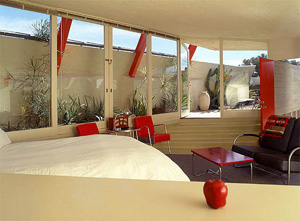 Photography by Joseph Pellegrini
Photography by Joseph Pellegrini
Steven Lowe had been working on The Beat Hotel for a couple of years when I met him. At the time (February 2004), I was editor of The Public Record and writing about his soon-to-open hotel.
My immediate impression of Steven — an impression that never dissipated — was that he was extremely intelligent, fascinating, and passionate. As he spoke about his former days as a friend and collaborator of William Burroughs and other Beat Generation icons, about the research he had undertaken to create the Desert Hot Springs Motel (designed by architect John Lautner) and The Beat Hotel, about his visions for attracting and inspiring architecture and literary buffs, I began to realize how fortunate this community was to have Steven in its midst.
I also enjoyed his humor and his fearlessness at seeking the less-traveled road through life. He told me the story about how he had come to meet Burroughs on the streets of New York. In his early 20s, Steven had just been fired from his job. He had been working for a publisher of pornographic literature, but had somehow gotten away with secretly writing experimental feminist novels instead of pornography. I can still recall the way he chuckled about his boss’ discovery. In any event, it turned out that Lowe’s loft was only four blocks from Burroughs and he recognized him on the street. No doubt Steven was as articulate then as he was when I interviewed him, because Burroughs sought his assistance writing Cities of the Red Night. The friendship grew, as did the collaborative work.
At the end of that interview, Steven offered to show me the Lautner property. I was so impressed that I pitched a story to Palm Springs Life Editor Steven Biller (The Public Record was also a Desert Publications Inc. product). The story appeared in the July 2004 issue.
I was delighted to have another opportunity to share Steven Lowe’s personality — and this time to a broader audience. Steven had put so much effort and so much heart into his Desert Hot Springs retreats that it needed to be recognized. They were more than re-creations of a time and place, more than collections of memorabilia and midcentury furnishings. They were Steven’s respectful homages to men he admired for their contributions to our culture.
Steven had an almost unhuman ability to absorb information, remember it in great detail, and eloquently articulate it. If he had not been such a generous, humble man, I would have felt intimidated by his intelligence. But he wasn’t that sort of person. Instead, he was someone who was genuinely interested in sharing his knowledge (born of curiosity and passion) and in introducing people to each other so they could share their own knowledge and interests.
I had the opportunity to enjoy Steven’s company on several occasions — a couple of times when he hosted gatherings at The Beat Hotel. He was kind to everyone, and it was obvious he had the respect of people from all walks of life.
Something Steven said during my Palm Springs Life interview stands out as I think about his life. In explaining why he paid so much attention to details, he said, “They’re all the threads that create the tapestry.” Now I think of that statement as the way he surrounded himself with people who became his friends.
— Janice Kleinschmidt
Read Janice’s July 2004 Palm Springs Life story about Steven Lowe.

